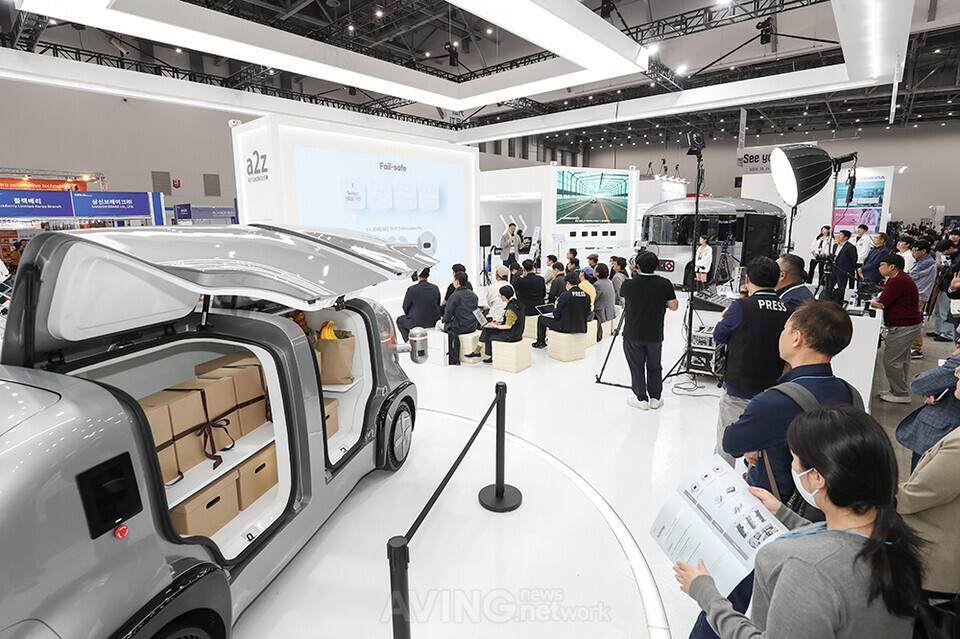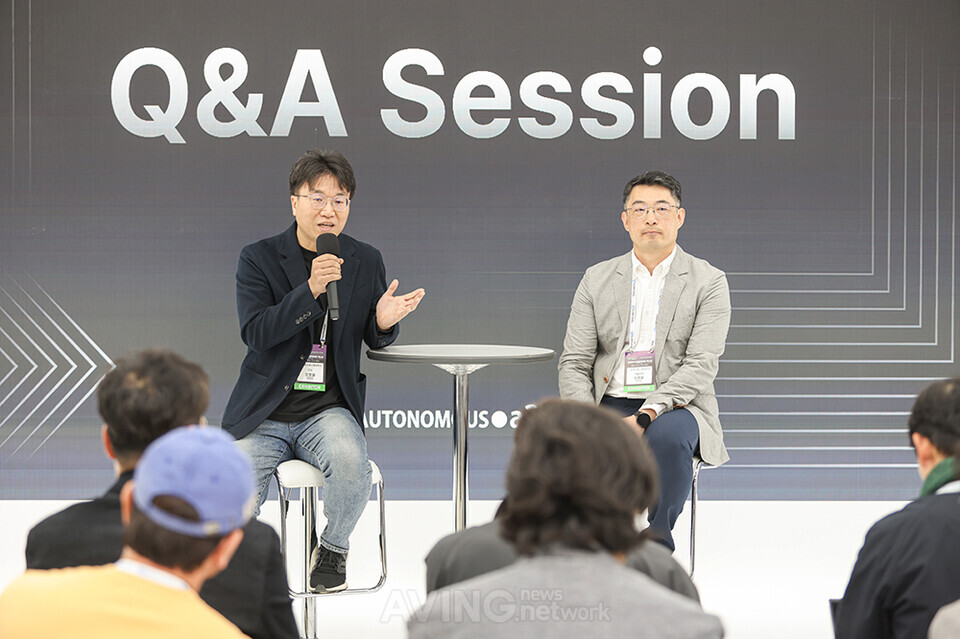Press Byungyong You, technical director of Autonomous a2z, announces that MS·SD autonomous vehicles will be demonstrated on public roads after pilot mass production in 2025.
페이지 정보
작성자 Autonomous a2z 조회 189 작성일 2023-10-30본문
- Media inquiries on development background of 12-seater driverless shuttle “MS,” prospects of entering overseas markets, etc.
- Series B investment process, commercialization plans, etc.
- Byungyong You, technical director, says "It will be available on public roads in 2025!” and “We will continue to develop and improve our technology!"
Yongchul Oh, CTO of Autonomous a2z (left), and Byungyong You, technical director of Autonomous a2z (right), answer reporters’ inquiries during a press conference held at the 2023 DIFA in October 19, 2023. | Photo by AVING NEWS
Autonomous a2z, an autonomous driving company
developing a driverless mobility platform, organized a press conference at the
“2023 Daegu International Future Auto & Mobility Expo (hereinafter
DIFA)" in Daegu EXCO from Thursday, October 19 to Saturday, October 21.
Autonomous a2z is an autonomous driving startup
founded in 2018 that has proven its technology through the largest number of
autonomous vehicles in Korea, the longest autonomous driving record in Korea,
and the largest number of temporary operation permit districts in Korea, and in
2023, it was ranked 13th in the global autonomous driving leaderboard evaluated
by the U.S. Guidehouse Insights.
Most importantly, Autonomous a2z didn't simply
demonstrate the technology, but actually operated autonomous vehicles to prove
the technology was real. In particular, the “Osong-Sejong Autonomous Bus"
operated directly by Autonomous a2z expanded its route from October 6, running
four times a day from Osong Station via the Sejong Government Complex to
Banseok Station in Daejeon, covering a round-trip distance of 64.4 kilometers,
becoming the first commercialized autonomous bus route in Korea.
In addition, the Daegu Technopolis-National
Industrial Complex area has been operating the “Dalgubeol Autonomous Vehicle+”
self-driving vehicle since November 2022, and through September this year, it
has achieved a cumulative number of 3,317 calls and about 6,000 passengers,
proving that it has both technology and safety.
In particular, at the 2023 DIFA, the “Dalgubeol
Autonomous Vehicle+” self-driving vehicle operated by Autonomous a2z completed
the course starting from the Expo and through the Dongdaegu area in just three
days and finished the event without a single accident. Sam Abuelsamid of global
market research firm Guidehouse Insights, who took the vehicle for a test drive
on Friday, October 20th, was impressed with the Autonomous a2z's ability to
navigate complex roads like Dongdaegu Station in just three days.
On Thursday, October 19th, the day of the
opening ceremony, Autonomous a2z unveiled its flagship autonomous vehicle model
“MS” (Middle Shuttle), which is soon to be mass-produced, as well as “SD”
(Small Delivery) and “Level 4 Autonomous Driving Software” technologies. In
addition, the media stage at the booth featured presentations on the company's
self-developed mass-produced autonomous vehicles, applied technologies,
commercialization plans, and future visions, as well as a Q&A session with
members of the Automobile Writers’ Association of Korea (AWAK).
During the Q&A session, Byungyong You,
technical director of Autonomous a2z, and Yongchul Oh, CTO of Autonomous a2z,
were present to answer questions from reporters. Here are the complete
questions and answers.

Q1. How did Autonomous a2z come to develop a
12-passenger driverless shuttle?
A. Director Byungyong You : We started by
developing Level 4 autonomous driving software that goes through the stages of
perception, determination, and control. We then spent four to five years
demonstrating autonomous vehicles by converting production vehicles developed
by OEMs into autonomous vehicles using sensors and controllers equipped with
software, which was not easy. For example, we wanted the vehicles (with the
software) to move as organically as we intended, but it wasn't easy. This is because
the vehicle was not built for Level 4 autonomous driving in the first place.
The performance of all 13 vehicles with the
software varied, and the degree of software compatibility varied from vehicle
to vehicle. The team decided that the perfect vessel for the autonomous driving
software was needed, so the “hardware,” a 12-seater driverless shuttle, was
developed. In the case of Tesla, the company has evolved where it is today by
building software and hardware in parallel.
Q2. According to this year's comprehensive
ranking of global autonomous driving technologies by global market research
firm Guidehouse Insights, Autonomous a2z is ranked 13th. With the exception of
Hyundai Motor Group and American Motional Inc., having a purely Korean company
on the list seems like a huge accomplishment. How did a startup grow so fast in
just five years?
A. Director Byungyong You : After passing a kind
of "paper assessment" conducted by Guidehouse Insights, and then
continuing to interview, evaluate, and receive feedback, we realized that our
strategy was on the right track.
Autonomous a2z has so far targeted business to
business (B2B) and business to government (B2G), not business to consumer
(B2C). When we saw the positive evaluation (from Guidehouse Insights) reflecting
the cumulative mileage we had gained by utilizing infrastructure, developing
our own technology, and conducting demonstrations involving the public, we
became confident in the strategy we had chosen. Since then, we've focused all
of our efforts on the Level 4 demonstration of autonomous vehicles, and we have
made good progress.
In this evaluation, the "strategy
score" was significantly higher than that of companies with trillions of
dollars in enterprise value. On the other hand, the "performance
score" was not as high. A performance score is a measure of a company's
ability to grow with the capital it currently has available. The score is to
assess, for example, whether the company has the capital to build and operate
1,000 self-driving vehicles.
So with this Series B investment, we're able to
show that the capital is there to actually mass produce (self-driving)
vehicles. I'm confident that if we build on this and work harder, we can move
up higher in the rankings. The goal is to move up from the current 13th place
to the competitor group and then to the leader group.

Q3. I understand that you recently participated
in the "COSMO Project" in Singapore, where you explained your
technology, strategy, etc. How was the reaction from the field? Will this
change the direction of your business in Singapore?
A. CTO Yongchul Oh: Singapore doesn't have a lot
of tech companies, so we're putting a lot of effort into attracting tech
companies. Self-driving companies were plentiful in the early days, but only a
few remain. Therefore, Singapore has been very welcoming of our presence in
their country through the COSMO project.
Singapore is at the top of the list of countries
we're looking to expand into. It is a city-state with well-established roads,
and it will be easy to prove the effectiveness of the LiDAR infrastructure
system. Within the COSMO project, the first LiDAR infrastructure system was
installed to prove that the system can help in terms of autonomous driving and
traffic safety.
For future projects, we plan to demonstrate the
use of “MS” and “SD” based on the LiDAR infrastructure system, and continue
promotions in light of this strategy.
Q4. Last October, Argo AI, a global autonomous
driving joint venture with an enterprise value of nearly KRW 10 trillion, went
bankrupt and never found a new owner. Now that Autonomous a2z is ahead of the
competition in the U.S. market, how do you plan to leverage this opportunity?
And what is your strategy for the U.S. market going forward?
A. Director Byungyong You : After the bankruptcy
filing of Argo AI, which received more than 1 trillion won in investment, it is
true that investment funds for the autonomous driving market have cooled
rapidly in Korea. In the case of our recent Series B investment, it took us a
very long time to explain and convince the investors of our strategy and
feasibility, and we finally got the investment last month.
It’s also true that there has been significant
changes in the way Guidehouse Insights and others evaluate companies after the
Argo AI bankruptcy. The focus used to be about the amount of investment a
company received, the size of the company, and the amount of capital it had,
but now it's about the viability, sustainability, and operability of the
company's technology. This is evidenced by Mobileye's rise to the top of the
leaderboard, displacing longtime leader Waymo LLC. The reason for this is
simple. This is because Mobileye has a roadmap for autonomous driving that
includes a 70% share of the global ADAS market. Therefore, instead of looking
at robot taxis or the B2C market, Autonomous a2z is working on a
demonstration-oriented business in cooperation with public institutions and the
central government (Ministry of Land, Infrastructure, and Transport).
Once the domestic demonstration work is completed,
we plan to start the demonstration in the U.S., but since the U.S. is a large
country, we consider entering the vehicle sensor-based market rather than
infrastructure. This is similar to the strategy employed by GM Cruise LLC and
Google Waymo LLC.

Q5. In the U.S., there have been recent
accidents involving Cruise Taxis and Tesla FSD (Full Self-Driving). What are
your responses to the technical engineering challenges in the field?
A. CTO Yongchul Oh: Looking at Cruise and
Tesla's FSD technology, I thought that fully autonomous driving in the form of
robot taxis was a bit far in the future, but it seems that this era is coming
sooner than I thought.
We’re still doing a lot of testing on incomplete
elements. It will take some time before we can rely on sensors alone for full
safety. Since our main business model is smart city solutions, we envision a
way to receive information from the infrastructure by combining infrastructure
solutions with remote driving, etc. In this way, we expect to be able to
recognize areas that sensors are unable to detect. The technology will be
developed in the direction of preventing human and vehicle accidents with the
help of control or remote driving in dangerous situations.
Q6. It is known that the company recently raised
34 billion won in Series B funding. It seems there are many tasks ahead of you,
and I'm curious to know where you plan to focus your efforts. Finally, what are
the next steps for the commercialization and wider deployment of autonomous
vehicles in public transportation?
A. Director Byungyong You : We’re planning
prototype mass production for both MS and SD platforms in the second half of
next year and pilot mass production in 2025.
We will first build a few dozen units to
demonstrate the technology in places where such activities are not restricted
by law, for instance on a university campus or in a factory laboratory. If no
problems are identified at this stage, we plan to demonstrate on general roads
(public roads) such as the Sejong BRT line in 2025. In particular, we plan to
deploy both MS and SD models in rural and mountainous regions and areas with
disadvantaged transportation. This is because the locations mentioned above
have real problems for residents, such as hiring drivers and reduced service
routes.
In addition, we have an IPO to investors
scheduled for the second half of 2025, so we will work diligently to prepare in
time.
Meanwhile, the 2023 DIFA, which has been held
for the seventh time in Daegu since 2017, covered the entire mobility industry,
including eco-friendly vehicles (electric and hydrogen), motorized parts such
as motors, batteries, and chargers, autonomous driving, and urban air mobility
(UAM) under the theme of “From
the ground to the sky, a new beginning of mobility.” In particular, as the Ministry of Land,
Infrastructure, and Transport and the Ministry of Trade, Industry, and Energy,
the co-host Ministries, are the two main pillars of policy promotion in
preparation for the era of full autonomous driving services and UAM
commercialization through 2027-2030, the exhibition showcased the technological
achievements supported by the policy focus and introduced the latest policy
directions.
→ Go to the 2023 DIFA news special page


